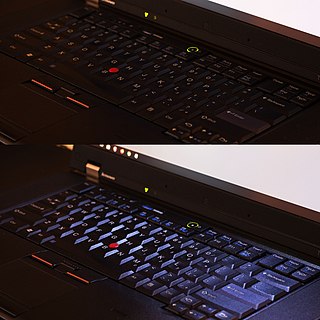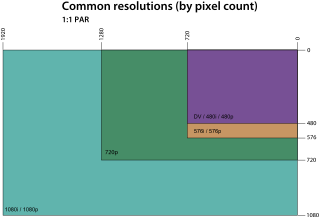Related Research Articles

A laptop computer or notebook computer, also known as a laptop or notebook for short, is a small, portable personal computer (PC). Laptops typically have a clamshell form factor with a flat panel screen on the inside of the upper lid and an alphanumeric keyboard and pointing device on the inside of the lower lid, although 2-in-1 PCs with a detachable keyboard are often marketed as laptops or as having a "laptop mode". Most of the computer's internal hardware is fitted inside the lower lid enclosure under the keyboard, although many laptops have a built-in webcam at the top of the screen and some modern ones even feature a touch-screen display. In most cases, unlike tablet computers which run on mobile operating systems, laptops tend to run on desktop operating systems which have been traditionally associated with desktop computers.

ThinkPad is a line of business-oriented laptop computers and tablets, the early models of which were designed, developed and marketed by IBM, starting in 1992. In 2005 IBM sold its PC business, including laptops to Lenovo. The Chinese manufacturer further developed the line, and is still selling new models in 2023.

A pointing stick is a small analog stick used as a pointing device typically mounted centrally in a computer keyboard. Like other pointing devices such as mice, touchpads or trackballs, operating system software translates manipulation of the device into movements of the pointer on the computer screen. Unlike other pointing devices, it reacts to sustained force or strain rather than to gross movement, so it is called an "isometric" pointing device. IBM introduced it commercially in 1992 on its laptops under the name "TrackPoint", and patented it in 1997. It has been used for business laptops, such as Acer's TravelMate, Dell's Latitude, HP's EliteBook and Lenovo's ThinkPad.

The IBM PC Convertible is a laptop computer made by IBM, first sold in April 1986. The Convertible was IBM's first laptop-style computer, following the luggable IBM Portable, and introduced the 3½-inch floppy disk format to the IBM product line. Like modern laptops, it featured power management and the ability to run from batteries.

The IBM ThinkPad 701 is a subnotebook in the ThinkPad line by IBM. The 701 is colloquially known as the Butterfly due to its sliding keyboard, which was designed by John Karidis. It was developed from 1993 and sold from March 1995 until later that year and priced between $1,499 and $3,299. The 701 was the most sold laptop in 1995 and has received 27 design awards. It was based on either the DX2 or the DX4 version of the Intel i486, combined with CT-65545 graphics chip from Chips and Technologies. The 701Cs version used a DSTN display, while the 701C used a TFT LCD. It was pre-installed with Windows 3.11 and for the DX4 models also with OS/2 Warp 3.0. The 701 was discontinued because the keyboard design was no longer a necessity after screen sizes increased. After its discontinuation there has been some speculation about a new notebook with a butterfly style keyboard.

A handheld personal computer (PC) is a pocket-sized computer typically built around a clamshell form factor and is significantly smaller than any standard laptop computer, but based on the same principles. It is sometimes referred to as a palmtop computer, not to be confused with Palmtop PC which was a name used mainly by Hewlett-Packard.

ThinkLight was a keyboard light present on many older ThinkPad families of notebook computers.

Subnotebook, also called ultraportable, superportable, or mini notebook, was a marketing term for laptop computers that are smaller and lighter than a typical notebook-sized laptop.

Richard Sapper was a German industrial designer who was based in Milan, Italy for much of his career. He is considered one of the most influential designers of his generation. His products typically feature a combination of technical innovation, simplicity of form, and an element of wit and surprise. He received numerous international design awards, including 11 Compasso d'Oro awards and the Raymond Loewy Foundation's Lucky Strike Designer Award. Examples of his work are held in many museums around the world, including the Victoria and Albert (V&A) and Design Museum in London, the Pompidou Center in Paris, the ADI Design Museum in Milan, and the Museum of Modern Art (MoMA) in New York, which counts over 17 of Sapper's designs in its collection.

Pen computing refers to any computer user-interface using a pen or stylus and tablet, over input devices such as a keyboard or a mouse.

The history of laptops describes the efforts, begun in the 1970s, to build small, portable Personal Computers that combine the components, inputs, outputs and capabilities of a Desktop Computer in a small chassis.

Tom Hardy is an American design strategist and Professor of Design Management at Savannah College of Art and Design (SCAD). As corporate design advisor to Samsung Electronics (1996-2003) Hardy was instrumental in transforming their brand image from follower to innovation leader by creating a new brand-design ethos: "Balance of Reason & Feeling", and building significant global brand equity through judicious use of design strategy and management. While at IBM (1970-1992), he was an award-winning industrial designer and later served as corporate head of the IBM Design Program responsible for worldwide identity. His leadership contributed to the revitalization of IBM's brand image via differentiated design such as the iconic ThinkPad.

The graphics display resolution is the width and height dimension of an electronic visual display device, measured in pixels. This information is used for electronic devices such as a computer monitor. Certain combinations of width and height are standardized and typically given a name and an initialism which is descriptive of its dimensions. A graphics display resolution can be used in tandem with the size of the graphics display to calculate pixel density. An increase in the pixel density often correlates with a decrease in the size of individual pixels on a display.
The history of tablet computers and the associated special operating software is an example of pen computing technology, and thus the development of tablets has deep historical roots. The first patent for a system that recognized handwritten characters by analyzing the handwriting motion was granted in 1914. The first publicly demonstrated system using a tablet and handwriting recognition instead of a keyboard for working with a modern digital computer dates to 1956.

A 2-in-1 PC, also known as convertible laptop, 2-in-1 tablet, 2-in-1 laptop, 2-in-1 detachable, laplet, tabtop, laptop tablet, or simply 2-in-1, is a portable computer that has features of both tablets and laptops.
John Karidis was a Greek-American mechanical engineer, inventor, and an Emeritus Distinguished Engineer at the IBM T.J. Watson Research Center. He graduated with BS, MS & PhD, (1976-1983) in Mechanical Engineering from Penn State University.
The IBM ThinkPad 500 is a subnotebook from the ThinkPad series released by IBM in 1993.

The IBM ThinkPad 700 is the first notebook computer for the ThinkPad brand that was released by IBM on October 5, 1992. Another series was released alongside it, the ThinkPad 300 series. The 300 series was meant to be a cheaper, lower performance model line over the 700. It was developed as a successor to the L40SX.

The IBM ThinkPad Power Series(800/820/821/822/823/850/851/860) is a laptop series from the ThinkPad line that was manufactured by IBM. It is based on the PowerPC architecture.

The IBM Leapfrog is a tablet computer prototype by IBM. It was designed by Sam Lucente and Richard Sapper. It is part of the collection of the Museum of Modern Art. It won the Compasso d'Oro in 1994. When the tablet computer was announced, it was mistakenly described by design magazines as a product that could be bought.
References
- ↑ "Sam Lucente: The Ethnographer" . Bloomberg News . June 19, 2006. Retrieved 2021-06-03.
- ↑ Breen, Bill (2007-10-01). "Streamlining HP". Fast Company . Retrieved 2021-06-03.
- ↑ Roberts, Sam (2016-01-05). "Richard Sapper, Designer of Sleek Housewares, Dies at 83". The New York Times. ISSN 0362-4331 . Retrieved 2021-06-03.
- ↑ "ThinkPad 701 Portable Computer". Museum of Modern Art . 112.1996. Retrieved August 20, 2021.
- ↑ "HP sees profit in design". Computerworld . Retrieved 2021-06-03.
- ↑ Shankland, Stephen. "Samsung wants you to care about every little tidbit in its phones so it won't have to pay Apple $1 billion". CNET . Retrieved 2021-06-03.